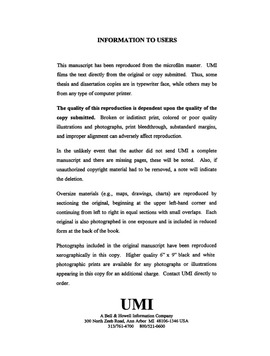| dc.contributor.advisor | Griswold, Robert L., | en_US |
| dc.contributor.author | Green, Ronald Simonds, Jr. | en_US |
| dc.date.accessioned | 2013-08-16T12:30:25Z | |
| dc.date.available | 2013-08-16T12:30:25Z | |
| dc.date.issued | 1998 | en_US |
| dc.identifier.uri | https://hdl.handle.net/11244/5755 | |
| dc.description.abstract | Over the twenty-year span of the 1940s and 1950s, a growing sense of separation and resistance to the mainstream culture developed, characterized by distinctive food, slang, music, dress, and sexual behavior. By studying the mores of their culture, we understand the impact of consumerism and of the professionalization of advice-giving. The behavior of teenagers became increasingly separate from the mainstream and ultimately oppositional, leading to the even more overt rebellion of the 1960s. | en_US |
| dc.description.abstract | By looking in particular at the magazines they read and the letters they wrote, as well as the peculiar vision expressed in hundreds of guidance films, we gain new insight into what made their culture work and, by implication, we better understand the changes in the larger American culture at mid-century. | en_US |
| dc.description.abstract | Beginning during the Second World War, adolescents developed a distinctive youth culture that grew increasingly autonomous in the decades which followed. Significantly, the word identifying them as a group apart began appearing in print: "teenagers. Because adults competed with each other for teenagers' attention, seeking to direct and control them for the adults' own purposes, young people found that the only consistent standards by which they could guide their own behavior were those determined by their peers. As parents vied with commercial groups appealing to the emerging youth market, and the increasingly influential therapeutic culture of counselors and advice-givers also pursued its own agenda, young people chose from a variety of cultural offerings. Finding no clear direction in the cacophony of adult voices speaking at cross-purposes, teenagers determined for themselves the standards of the culture they created. | en_US |
| dc.format.extent | xii, 425 leaves ; | en_US |
| dc.subject | Mass media and teenagers United States. | en_US |
| dc.subject | Youths' periodicals United States. | en_US |
| dc.subject | American Studies. | en_US |
| dc.subject | History, United States. | en_US |
| dc.subject | Teenagers Conduct of life United States. | en_US |
| dc.title | Innovation, imitation, and resisting manipulation: The first twenty years of American teenagers, 1941-1961. | en_US |
| dc.type | Thesis | en_US |
| dc.thesis.degree | Ph.D. | en_US |
| dc.thesis.degreeDiscipline | Department of History | en_US |
| dc.note | Major Professor: Robert L. Griswold. | en_US |
| dc.note | Source: Dissertation Abstracts International, Volume: 59-12, Section: A, page: 4511. | en_US |
| ou.identifier | (UMI)AAI9914408 | en_US |
| ou.group | College of Arts and Sciences::Department of History | |
